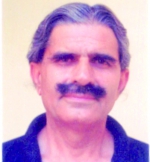- Home
- Columnists
- Charudutta Panigrahi

Charudutta Panigrahi
Locals believed till recently that when Varun, the Lord of the Sea is peeved, the sea level rises and encroaches the habitation. Many also worship Laxmi, the daughter of Varun, with the hope that this would help propitiate the sea God. They are right. The Sea is angry and often during full moon nights, when the rest of the world soaks in moonlight, spawning romance and love, Satabhaya region in Odisha’s Kendrapada district is devastated.
High tides in the Bay of Bengal spill over to thousands of acres of agricultural land (it swamped over 1,200 acres earlier this month). August 1, being the full moon day, the high tides hit the coast and flooded the cultivated fields in Rabindrapalli and Dantiapada moujas under Satabhaya area. The Panchayat was cordoned by sea water. No embankment near Rabindrapalli or Dantiapada could resist the transgressions of the sea.
It is so dramatic that every year with the sea-level rise, the coastal systems in the districts of Kendrapara, Puri and others experience increased levels of inundation and storm flooding, accelerated coastal erosion, seawater intrusion into fresh groundwater and encroachment of tidal waters into river systems.
As if the constant battering of Odisha through natural disasters (Super Cyclone of 1999, Cyclone Phailin, Hud Hud, Heat wave 98) were not enough, the rise in sea level and the expansion of the Bay of Bengal towards the coast regularly engulfs villages, farm lands and erodes the capacities of the villagers who live along the coastline and derive most of their livelihood from the sea.
Once proud of a coastline of 480kms, the people of Odisha are now wary of the disaster it abates. Over 100kms out of the State’s 480km long coastline ar facing erosion. Many villages have been the victims of the wrath of the ocean, almost at regular intervals and continuously.In 1930, Satabhaya, meaning a group of seven, was an area of 320 sq km near the port town of Paradip. The 2000 land records indicated the area to be 155 sqkm with five of the seven villages being swallowed by the sea.
The first to be ‘eaten’ by the sea were Govindpur, Mahnipur and Kuanriora villages in the early 1980s. Two more villages — Kharikula and Sarpada — were submerged in the mid-1990s. Satabhaya and Kanhapur villages are almost waiting to be choked. Kanhapur village has as an important place in Odisha’s progressive maritime history in trade and commerce. The village was the home of Tapoi, a folk character epitomising Odisha’s waterways and life around maritime trade.
In the recent past this village has shifted itself thrice leaving its original location a kilometre inside the Bay of Bengal. Besides Satabhaya and Kanhapur, 20 other villages along the coast are at high risk. Most have lost around 60 per cent of their land to the sea. Many villages in Puri district are also endangered due to the tidal waves. It is estimated that the economic impact of a one metre sea-level rise on coastal district like Puri or Balasore in Odisha could be well over Rs460 crore.
In the absence of measures and protection, a one metre sea level rise will inundate an area of 1,70,000 hectare. Drought in 2001 caused an economic loss of about `643 crore in Odisha, due to crop damage and affected 11 million people. Floods in 2001 inundated 25 of the 30 districts. Due to such calamities, an average 9,00,000 hectare of agricultural land lose crop every year in the State’s predominantly prime agricultural land — and displace 0.7 million people.
An additional 4,000 km of dykes and sea walls will be required to protect the area. The waves invade the villages every time the sea turns rough; even the artificial sand barrier is no protection. When storms like Cyclone Aila strike, waves of saline water breach the embankment and inundate nearby villages. Huge stretches of land now lie fallow.
In Puri district, the coastal villages of Astaranga block are severely affected by tidal waves. Hardly 15km east of Chandrabhaga, the villagers of Udaykani, Chhenu, Tandahar, Kalamakani, Katakana and Kaanarapur of Astaranga block are perennially under pressure of the tidal waves, as they have been re-locating again and again from their habitations in recent years.
The locals are not be averse to mass exodus: In the last 20 years, the area has witnessed more floods, more rain and more low pressures. Summer has become harsh as humidity goes higher than ever before. The onslaught of the sea has been so cruel that the people living on the coasts expressed their desire to shift to a safer place leaving their homeland and farmland.
(The writer is Mentor, Forum for Integrated Development and Research. He is a technocrat and public policy expert)







































